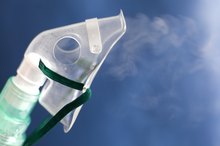What does fact checked mean?
At Healthfully, we strive to deliver objective content that is accurate and up-to-date. Our team periodically reviews articles in order to ensure content quality. The sources cited below consist of evidence from peer-reviewed journals, prominent medical organizations, academic associations, and government data.
The information contained on this site is for informational purposes only, and should not be used as a substitute for the advice of a professional health care provider. Please check with the appropriate physician regarding health questions and concerns. Although we strive to deliver accurate and up-to-date information, no guarantee to that effect is made.
Swimming With a Tracheostomy
If you enjoy swimming but have a tracheostomy, or tracheotomy, you do not necessarily have to forgo this activity 1. A tracheostomy is a medical procedure characterized by surgically creating a hole in the throat to provide direct access to the trachea, or windpipe, when normal breathing is impaired. With medical clearance and specialized equipment, you can swim with a tracheostomy, though it may be dangerous.
About Tracheostomies
A tracheostomy incision is kept open and functional by inserting a specially fitted tracheostomy tube directly into the trachea, which allows patients to breathe without using their mouth or nose. The tracheostomy tube is attached using tracheostomy tube ties and hook and loop straps. Post-surgery care includes using saline solution and suctioning equipment to keep the area clean and remove unwanted mucus or saliva. If blood is present at the tracheostomy site, contact your doctor immediately as this could indicate serious complications. Swimming immediately after a tracheostomy is ill-advised because the body hasn’t been given sufficient time to adjust to the equipment.
- A tracheostomy incision is kept open and functional by inserting a specially fitted tracheostomy tube directly into the trachea, which allows patients to breathe without using their mouth or nose.
- Post-surgery care includes using saline solution and suctioning equipment to keep the area clean and remove unwanted mucus or saliva.
Tracheostomy and Swimming
Swimming With a Catheter
Learn More
Swimming with a tracheostomy generally is not recommended by doctors 1. Tracheostomy patients must use specialized swimming equipment that prevents water from being ingested through the stoma, or incision site. Physicians often advise tracheostomy patients to avoid swimming without using proper equipment because water can travel directly to the lungs. Inhaling water significantly increases your drowning risk, so consult your doctor before swimming with a tracheostomy.
- Swimming with a tracheostomy generally is not recommended by doctors 1.
- Physicians often advise tracheostomy patients to avoid swimming without using proper equipment because water can travel directly to the lungs.
Tracheostomy Swimming Equipment
Specialized equipment designed for swimming with a tracheostomy includes an apparatus that attaches to the stoma site and suctions water away from the tracheostomy tube as well as a stoma cap. Some public swimming pools require tracheostomy patients to obtain and provide medical clearance before gaining permission to use the swimming facilities. In some instances, tracheostomy patients must sign a waiver releasing the facility from all legal liability before swimming.
Dangers
How to Swim With Oxygen
Learn More
The main threat of swimming with a tracheostomy is water aspiration, which is the introduction of liquids or solids into the trachea instead of the esophagus. The risk of aspiration greatly increases when swimming with a tracheostomy because of the tracheostomy tube’s placement. Because the tube is located below the pharyngeal, or gag, reflex, water can easily enter the lungs without any physical attempts to prevent it. Pediatric tracheostomy patients are more likely to aspirate water and should not be permitted to swim. Aspiration can cause stoma site infection, serious brain trauma or death.
- The main threat of swimming with a tracheostomy is water aspiration, which is the introduction of liquids or solids into the trachea instead of the esophagus.
- The risk of aspiration greatly increases when swimming with a tracheostomy because of the tracheostomy tube’s placement.
Related Articles
References
- Johns Hopkins Medicine: Swimming With a Tracheotomy
- MedLine Plus: Tracheostomy Care
- Johns Hopkins Medicine: What is a Tracheostomy?
- Porr J, Laframboise M, Kazemi M. Traumatic hyoid bone fracture - a case report and review of the literature. J Can Chiropr Assoc. 2012;56(4):269-74.
- Ganuza JR, Oliviero A. Tracheostomy in spinal cord injured patients. Transl Med UniSa. 2011;1:151-72.
- National Heart, Blood, and Lung Institute. Tracheostomy.
- O'Connor HH, White AC. Tracheostomy decannulation. Respiratory Care. 2010:55(8):1076-1081.
- Fernandez-bussy S, Mahajan B, Folch E, Caviedes I, Guerrero J, Majid A. Tracheostomy tube placement: early and late complications. J Bronchology Interv Pulmonol. 2015;22(4):357-64. doi:10.1097/LBR.0000000000000177
- Johns Hopkins Medicine. Complications and Risks of Tracheostomy.
- Engels PT, Bagshaw SM, Meier M, Brindley PG. Tracheostomy: from insertion to decannulation. Can J Surg. 2009;52(5):427-33.
- American Nurse Today. Tracheostomy care: An evidence-based guide. Published July 11, 2011.
- Johns Hopkins Medicine. Decannulation.
- Medscape. Tracheostomy. Updated December 2018.
Writer Bio
Based in Birmingham, Ala., MekaSeay Jones began writing in 2005. Her work has appeared in "Shoals Woman Magazine" and various newspapers. Jones is pursuing a Ph.D. in exercise science from the University of Alabama. She holds M.A.Ed. and B.S. degrees in health and physical education.









